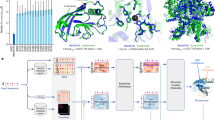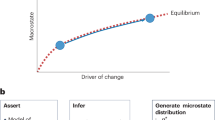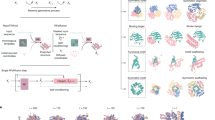Abstract
Four independent structures of human interleukin–4, two determined by nuclear magnetic resonance techniques and two by X–ray diffraction, have been compared in detail. The core of this four helix bundle protein is very similar in all the structures but there are some differences in loop regions that are known to be mobile in solution. Careful comparison of the experimental data sets and the methods of analysis of the different laboratories has provided clues to the sources of most of the differences, and also answered some general questions about the accuracy of protein structure determination by these two techniques.
This is a preview of subscription content, access via your institution
Access options
Subscribe to this journal
Receive 12 print issues and online access
$189.00 per year
only $15.75 per issue
Buy this article
- Purchase on Springer Link
- Instant access to full article PDF
Prices may be subject to local taxes which are calculated during checkout
Similar content being viewed by others
References
Billeter, M. Comparison of protein structures determined by NMR in solution and by X-ray diffraction in single crystals. Q. Rev. Biophys. 25, 325–377 (1992).
Billeter, M., Kline, A.D., Braun, W., Huber, R. & Wüthrich, K. Comparison of the high-resolution structures of the α-amylase inhibitor tendamistat determined by nuclear magnetic resonance in solution and by X-ray diffraction in single crystals. J. molec. Biol. 206, 677–687 (1989).
Clore, G.M. & Gronenborn, A.M. Comparison of the solution nuclear magnetic resonance and X-ray structures of human recombinant interleukin-1β. J. molec. Biol. 221, 47–53 (1991).
Berndt, K.D., Güntert, P., Orbons, L.P.M. & Wüthrich, K. Determination of a high-quality nuclear magnetic resonance solution structure of the bovine pancreatic trypsin inhibitor and comparison with three crystal structures. J. molec. Biol. 227, 757–775 (1992).
Baldwin, E.T. et al. Crystal structure of interleukin-8: symbiosis of NMR and crystallography. Proc. natn. Acad. Sci. U.S.A. 88, 502–506 (1991).
Clore, G.M. & Gronenborn, A.M. Comparison of the solution nuclear magnetic resonance and crystal structures of interleukin-8 Possible implications for the mechanism of receptor binding. J. molec. Biol. 217, 611–620 (1991).
Furey, W.F. et al. Crystal structure of Cd, Zn metallothioneine. Science 231, 704–710 (1986).
Schultze, P. et al. Conformation of [Cd7] metallothionein-2 from rat liver in aqueous solution determined by nuclear magnetic resonance spectroscopy. J. molec. Biol. 203, 251–268 (1988).
Shaanan, B. et al. Combining experimental information from crystal and solution studies: joint X-ray and NMR refinement. Science, 257, 961–964 (1992).
Smith, L.J. et al. Human interleukin 4: The solution structure of a four-helix bundle protein. J. molec. Biol. 224, 900–904 (1992).
Powers, R. et al. Three-dimensional solution structure of human interleukin-4 by multidimensional heteronuclear magnetic resonance spectroscopy. Science 256, 1673–1677 (1992).
Wlodawer, A., Pavlovsky, A. & Gustchina, A. Crystal structure of human recombinant interleukin-4 at 2.25 Å resolution. FEBS Lett. 309, 59–64 (1992).
Walter, M.R. et al. Crystal structure of recombinant human interleukin-4. J. biol. Chem.. 267, 20371–20376 (1992).
Redfield, C. et al. Secondary structure and topology of human interleukin 4 in solution. Biochemistry 30, 11029–11035 (1991).
Garrett, D.S. et al. Determination of the secondary structure andfolding topology of human interleukin-4 using three-dimensionalheteronuclear magnetic resonance spectroscopy. Biochemistry 31, 4347–4353 (1992).
Powers, R. et al. The high-resolution three-dimensional solutionstructure of human interleukin-4 determined by multi-dimensionalheteronuclear magnetic resonance spectroscopy. Biochemistry 32, 6744–6762 (1993).
Redfield, C. et al. Loop mobility in a four-helix-bundle protein: 15N NMR relaxation measurements on human interleukin-4. Biochemistry 31, 10431–10437 (1992).
Kabsch, W. & Sanders, C. Dictionary of protein secondary structure: pattern recognition of hydrogen-bonded and geometrical features. Biopolymers 22, 2577–2637 (1983).
Schulz, G.E. & Schirmer, R.H. Principles of Protein Structure. (Springer-Verlag, New York, 1979).
Morris, A.L., MacArthur, M.W., Hutchinson, E.G. & Thornton, J.M. Stereochemical quality of protein structure coordinates. Proteins 12, 345–364 (1992).
Brünger, A.T. X-plor version 3 1. A system for X-ray crystallography and NMR (Yale University Press, 1992).
Wüthrich, K. NMR of Protein and Nucleic Acids (Wiley, New York, 1986).
Powers, R. et al. 1H, 15N, 13C and 13CO assignments of humaninterleukin-4 using three-dimensional double- and triple- resonance heteronuclear magnetic resonance spectroscopy. Biochemistry 32, 4334–4347 (1992).
Nilges, M., Kuszewski, J. & Brünger, A.T. Sampling properties of simulated annealing and distance geometry. Proceedings of the NATO Advanced Research Workshop on Computational Aspects of the Study of Biological Macromolecules by NMR. (Il Ciocco, Italy, 1991) 451–455 (Plenum Press, New York).
Nilges, M., Gronenborn, A.M., Brünger, A.T. & Clore, G.M. Determination of three-dimensional structures of proteins by simulated annealing with interproton distance restraints Application to crambin, potato carboxypeptidase inhibitor and barley serine proteinase inhibitor 2. Prot. Engng. 2, 27–38 (1988).
Nilges, M., Clore, G.M. & Gronenborn, A.M. Determination of three-dimensional structures of proteins from interproton distance data by hybrid distance geometry-dynamical simulated annealing calculations. FEBS Lett. 229, 317–324 (1988).
Brünger, A.T., Clore, G.M., Gronenborn, A.M. & Karplus, M. Application of molecular dynamics with interproton distance restraints: application to crambin. Proc. natn. Acad. Sci. U.S.A. 83, 3801–3805 (1986).
Clore, G.M. et al. The three-dimensional structure of α1-purothionin in solution: combined use of nuclear magnetic resonance, distance geometry and restrained molecular dynamics. EMBO J. 5, 2729–2735 (1986).
Satow, Y., Cohen, G.H., Padlan, E.A. & Davies, D.A. Phosphocholine binding immunoglobulin Fab McPC603. An X-ray diffraction study at 2.7 Å. J. molec. Biol. 190, 593–604 (1986).
Kraulis, P. MOLSCRIPT: a program to produce both detailed and schematic plots of protein structures. J. appl. Crystallogr. 24, 946–950 (1991).
Author information
Authors and Affiliations
Rights and permissions
About this article
Cite this article
Smith, L., Redfield, C., Smith, R. et al. Comparison of four independently determined structures of human recombinant interleukin–4. Nat Struct Mol Biol 1, 301–310 (1994). https://doi.org/10.1038/nsb0594-301
Received:
Accepted:
Issue Date:
DOI: https://doi.org/10.1038/nsb0594-301



